Use of MODIS Sensor Images Combined with Reanalysis Products to Retrieve Net Radiation in Amazonia
Abstract
:1. Introduction
2. Materials and Methods
2.1. Study Area
Flux Tower Sites
2.2. Land Cover Data
2.3. Observational Data
2.4. MODIS Data
2.5. Reanalysis Data
2.6. Estimation of Net Radiation
2.7. Validation
3. Results and Discussion
3.1. Spatio-Temporal Dynamics of the Components of Net Radiation over the Upper Tapajos and Curua-Una River Basins
3.1.1. Incoming Shortwave Radiation
3.1.2. Albedo
3.1.3. Incoming Longwave Radiation
3.1.4. Outgoing Longwave Radiation
3.1.5. Net Radiation
3.2. Temporal Dynamics of Net Radiation for Different Land Cover Types
3.3. Validation of Reanalysis Data
3.4. Validation of Model Estimates
4. Conclusions
Acknowledgments
Author Contributions
Conflicts of Interest
References
- Nepstad, D.C.; Stickler, C.M.; Soares-Filho, B.; Merry, F. Interactions among Amazon land use, forests and climate: Prospects for a near-term forest tipping point. Philos. Trans. R. Soc. B 2008, 1498, 1737–1746. [Google Scholar] [CrossRef] [PubMed]
- Egler, M.; Egler, C.A.G.; Franz, B.; de Araujo, M.S.M.; de Freitas, M.A.V. Indicators of Deforestation in the Southern Brazilian Pre-Amazon. Reg. Environ. Chang. 2013, 2, 263–271. [Google Scholar] [CrossRef]
- Gash, J.H.; Huntingford, C.; Marengo, J.A.; Betts, R.A.; Cox, P.M.; Fisch, G.; Fu, R.; Gandu, A.W.; Harris, P.P.; Machado, L.A.T.; et al. Amazonian climate: Results and future research. Theor. Appl. Climatol. 2004, 78, 187–193. [Google Scholar] [CrossRef]
- Werth, D.; Avissar, R. The local and global effects of Amazon deforestation. J. Geophys. Res. Atmos. 2002, 107, 1–8. [Google Scholar] [CrossRef]
- Aragão, L.E.; Poulter, B.; Barlow, J.B.; Anderson, L.O.; Malhi, Y.; Saatchi, S.; Phillips, O.L.; Gloor, E. Environmental change and the carbon balance of Amazonian forests. Biol. Rev. 2014, 4, 913–931. [Google Scholar] [CrossRef] [PubMed]
- Bastiaanssen, W.G.M.; Menenti, M.; Feddes, R.A.; Holtslag, A.A.M. A remote sensing surface energy balance algorithm for land (SEBAL). 1. Formulation. J. Hydrol. 1998, 212, 198–212. [Google Scholar] [CrossRef]
- Bisht, G.; Bras, R.L. Estimation of net radiation from the MODIS data under all sky conditions: Southern Great Plains case study. Remote Sens. Environ. 2010, 7, 1522–1534. [Google Scholar] [CrossRef]
- Bisht, G.; Venturini, V.; Islam, S.; Jiang, L.E. Estimation of the net radiation using MODIS (Moderate Resolution Imaging Spectroradiometer) data for clear sky days. Remote Sens. Environ. 2005, 1, 52–67. [Google Scholar] [CrossRef]
- Hou, J.; Jia, G.; Zhao, T.; Wang, H.; Tang, B. Satellite-based estimation of daily average net radiation under clear-sky conditions. Adv. Atmos. Sci. 2014, 3, 705–720. [Google Scholar] [CrossRef]
- Fisher, J.B.; Malhi, Y.; Bonal, D.; da Rocha, H.R.; de Araujo, A.C.; Gamo, M.; Goulden, M.L.; Hirano, T.; Huete, A.R.; Kondo, H.; et al. The land-atmosphere water flux in the tropics. Glob. Chang. Biol. 2009, 11, 2694–2714. [Google Scholar] [CrossRef]
- Baker, I.T.; Harper, A.B.; da Rocha, H.R.; Denning, A.S.; Araújo, A.C.; Borma, L.S.; Freitas, H.C.; Goulden, M.L.; Manzi, A.O.; Miller, S.D.; et al. Surface ecophysiological behavior across vegetation and moisture gradients in tropical South America. Agric. For. Meteorol. 2013, 182, 177–188. [Google Scholar] [CrossRef]
- Shuttleworth, W.J. Evaporation from Amazonian rainforest. Proc. R. Soc. Lond. B 1988, 1272, 321–346. [Google Scholar] [CrossRef]
- Garstang, M.; Greco, S.; Scala, J.; Swap, R.; Ulanski, S.; Fitzjarrald, D.; Martin, D.; Browell, E.; Shipman, M.; Connors, V.; et al. The Amazon boundary-layer experiment (ABLE 2B): A meteorological perspective. Bull. Am. Meteorol. Soc. 1990, 1, 19–32. [Google Scholar] [CrossRef]
- Gash, J.H.C.; Nobre, C.A. Climatic effects of Amazonian deforestation: Some results from ABRACOS. Bull. Am. Meteorol. Soc. 1997, 5, 823–830. [Google Scholar] [CrossRef]
- Martin, S.T.; Artaxo, P.; Machado, L.A.T.; Manzi, A.O.; Souza, R.A.F.; Schumacher, C.; Wang, J.; Andreae, M.O.; Barbosa, H.M.J.; Fan, J.; et al. Introduction: Observations and Modeling of the Green Ocean Amazon (GoAmazon2014/5). Atmos. Chem. Phys. 2015, 21, 30175–30210. [Google Scholar] [CrossRef]
- Artaxo, P. Break down boundaries in climate research. Nature 2012, 7381, 239. [Google Scholar] [CrossRef] [PubMed]
- Gonçalves, L.G.G.; Borak, J.S.; Costa, M.H.; Saleska, S.R.; Baker, I.; Restrepo-Coupe, N.; Muza, M.N.; Poulter, B.; Verbeeck, H.; Fisher, J.B.; et al. Overview of the large-scale biosphere-atmosphere experiment in Amazonia Data Model Intercomparison Project (LBA-DMIP). Agric. For. Meteorol. 2013, 182, 111–127. [Google Scholar] [CrossRef]
- Martínez, B.; Gilabert, M.A. Vegetation dynamics from NDVI time series analysis using the wavelet transform. Remote Sens. Environ. 2009, 9, 1823–1842. [Google Scholar] [CrossRef]
- Bontemps, S.; Herold, M.; Kooistra, L.; van Groenestijn, A.; Hartley, A.; Arino, O.; Moreau, I.; Defourny, P. Revisiting land cover observations to address the needs of the climate modelling community. Biogeosciences 2012, 6, 2145–2157. [Google Scholar] [CrossRef] [Green Version]
- Gong, P.; Wang, J.; Yu, L.; Zhao, Y.; Zhao, Y.; Liang, L.; Niu, Z.; Huang, X.; Fu, H.; Liu, S.; et al. Finer resolution observation and monitoring of global land cover: First mapping results with Landsat TM and ETM+ data. Int. J. Remote Sens. 2013, 7, 2607–2654. [Google Scholar] [CrossRef]
- Yang, J.; Gong, P.; Fu, R.; Zhang, M.; Chen, J.; Liang, S.; Xu, B.; Shi, J.; Dickinson, R. The role of satellite remote sensing in climate change studies. Nat. Clim. Chang. 2013, 10, 875–883. [Google Scholar] [CrossRef]
- Zhong, M.; Weill, A.; Taconet, O. Estimation of net radiation and surface heat fluxes using NOAA-7 satellite infrared data during fair-weather cloudy situations of MESOGERS-84 experiment. Boun. Layer Meteorol. 1990, 4, 353–370. [Google Scholar] [CrossRef]
- Samani, Z.; Bawazir, A.S.; Bleiweiss, M.; Skaggs, R.; Tran, V.D. Estimating daily net radiation over vegetation canopy through remote sensing and climatic data. J. Irrig. Drain. Eng. 2007, 4, 291–297. [Google Scholar] [CrossRef]
- Kim, H.Y.; Liang, S. Development of a hybrid method for estimating land surface shortwave net radiation from MODIS data. Remote Sens. Environ. 2010, 11, 2393–2402. [Google Scholar] [CrossRef]
- Fausto, M.A.; Machado, N.G.; de Souza Nogueira, J.; Biudes, M.S. Net radiation estimated by remote sensing in Cerrado areas in the Upper Paraguay River Basin. J. Appl. Remote Sens. 2014, 1, 1–17. [Google Scholar] [CrossRef]
- Wang, D.; Liang, S.; He, T.; Shi, Q. Estimating clear-sky all-wave net radiation from combined visible and shortwave infrared (VSWIR) and thermal infrared (TIR) remote sensing data. Remote Sens. Environ. 2015, 167, 31–39. [Google Scholar] [CrossRef]
- Wang, Y.; Tian, Y.; Zhang, Y.; El-Saleous, N.; Knyazikhin, Y.; Vermote, E.; Myneni, R.B. Investigation of product accuracy as a function of input and model uncertainties: Case study with SeaWiFS and MODIS LAI/FPAR algorithm. Remote Sens. Environ. 2001, 3, 299–313. [Google Scholar] [CrossRef]
- Schroeder, T.A.; Hember, R.; Coops, N.C.; Liang, S. Validation of solar radiation surfaces from MODIS and reanalysis data over topographically complex terrain. J. Appl. Meteorol. Climatol. 2009, 12, 2441–2458. [Google Scholar] [CrossRef]
- Liang, S.; Wang, K.; Zhang, X.; Wild, M. Review on estimation of land surface radiation and energy budgets from ground measurement, remote sensing and model simulations. IEEE J. Sel. Top. Appl. Earth Obs. Remote Sens. 2010, 3, 225–240. [Google Scholar] [CrossRef]
- Jin, Y.; Randerson, J.T.; Goulden, M.L. Continental-scale net radiation and evapotranspiration estimated using MODIS satellite observations. Remote Sens. Environ. 2011, 9, 2302–2319. [Google Scholar] [CrossRef]
- Shi, Q.; Liang, S. Characterizing the surface radiation budget over the Tibetan Plateau with ground-measured, reanalysis, and remote sensing data sets: 2. Spatiotemporal analysis. J. Geophys. Res. Atmos. 2013, 16, 8921–8934. [Google Scholar] [CrossRef]
- Kalnay, E.; Kanamitsu, M.; Kistler, R.; Collins, W.; Deaven, D.; Gandin, L.; Iredell, M.; Saha, S.; White, G.; Woollen, J.; et al. The NCEP/NCAR 40-year reanalysis project. Bull. Am. Meteorol. Soc. 1996, 3, 437–471. [Google Scholar] [CrossRef]
- Rodell, M.; Houser, P.R.; Jambor, U.E.A.; Gottschalck, J.; Mitchell, K.; Meng, C.J.; Arsenault, K.; Cosgrove, B.; Radakovich, J.; Bosilovich, M.; et al. The global land data assimilation system. Bull. Am. Meteorol. Soc. 2004, 3, 381–394. [Google Scholar] [CrossRef]
- Sheffield, J.; Goteti, G.; Wood, E.F. Development of a 50-year high-resolution global dataset of meteorological forcings for land surface modeling. J. Clim. 2006, 13, 3088–3111. [Google Scholar] [CrossRef]
- Santos, C.C.D.; Nascimento, R.L.; Rao, T.V.R.; Manzi, A.O. Net radiation estimation under pasture and forest in Rondônia, Brazil, with TM Landsat 5 images. Atmosfera 2011, 4, 435–446. [Google Scholar]
- Oliveira, G.; Moraes, E. Validation of net radiation obtained through MODIS/TERRA data in Amazonia with LBA surface measurements. Acta Amazon. 2013, 3, 353–364. [Google Scholar] [CrossRef]
- Eidt, R.C. The Climatology of South América. In Biogegraphy and Ecology in South America; Fittkau, E.J., Illies, J., Klinge, H., Schwabe, G.H., Sioli, J.C.H., Eds.; Dr. W. Junk: The Hague, The Netherlands, 1968; pp. 54–81. [Google Scholar]
- Lola, A.C.; Uchoa, P.W.; Júnior, J.A.S.; Cunha, A.C.; Feitosa, J.R.P. Term-hygrometric variations and influences of process of urban expansion in a city of equatorial midsize. Braz. Geogr. J. Geosci. Hum. Res. Med. 2013, 2, 615–632. [Google Scholar]
- Saleska, S.R.; Miller, S.D.; Matross, D.M.; Goulden, M.L.; Wofsy, S.C.; da Rocha, H.R.; de Camargo, P.B.; Crill, P.; Daube, B.C.; de Freitas, H.C.; et al. Carbon in Amazon forests: Unexpected seasonal fluxes and disturbance-induced losses. Science 2003, 5650, 1554–1557. [Google Scholar] [CrossRef] [PubMed]
- Silver, W.L.; Neff, J.; McGroddy, M.; Veldkamp, E.; Keller, M.; Cosme, R. Effects of soil texture on belowground carbon and nutrient storage in a lowland Amazonian forest ecosystem. Ecosystems 2000, 2, 193–209. [Google Scholar] [CrossRef]
- Telles, E.D.C.C.; de Camargo, P.B.; Martinelli, L.A.; Trumbore, S.E.; da Costa, E.S.; Santos, J.; Higuchi, N.; Oliveira, R.C. Influence of soil texture on carbon dynamics and storage potential in tropical forest soils of Amazonia. Glob. Biogeochem. Cycles 2003, 2, 1–12. [Google Scholar] [CrossRef]
- Hunter, M.O.; Keller, M.; Victoria, D.; Morton, D.C. Tree height and tropical forest biomass estimation. Biogeosciences 2013, 12, 8385–8399. [Google Scholar] [CrossRef]
- Hutyra, L.R.; Munger, J.W.; Saleska, S.R.; Gottlieb, E.; Daube, B.C.; Dunn, A.L.; Amaral, D.F.; de Camargo, P.B.; Wofsy, S.C. Seasonal controls on the exchange of carbon and water in an Amazonian rain forest. J. Geophys. Res. Biogeosci. 2007, 112, 1–16. [Google Scholar] [CrossRef]
- Miller, S.D.; Goulden, M.L.; da Rocha, H.R. The effect of canopy gaps on subcanopy ventilation and scalar fluxes in a tropical forest. Agric. For. Meteorol. 2007, 1, 25–34. [Google Scholar] [CrossRef]
- Restrepo-Coupe, N.; da Rocha, H.R.; Hutyra, L.R.; da Araujo, A.C.; Borma, L.S.; Christoffersen, B.; Cabral, O.M.; de Camargo, P.B.; Cardoso, F.L.; da Costa, A.C.L.; et al. What drives the seasonality of photosynthesis across the Amazon basin? A cross-site analysis of eddy flux tower measurements from the Brasil flux network. Agric. For. Meteorol. 2013, 182, 128–144. [Google Scholar] [CrossRef]
- Sakai, R.K.; Fitzjarrald, D.R.; Moraes, O.L.; Staebler, R.M.; Acevedo, O.C.; Czikowsky, M.J.; Silva, R.D.; Brait, E.; Miranda, V. Land-use change effects on local energy, water, and carbon balances in an Amazonian agricultural field. Glob. Chang. Biol. 2004, 5, 895–907. [Google Scholar] [CrossRef]
- Rice, A.H.; Pyle, E.H.; Saleska, S.R.; Hutyra, L.; Palace, M.; Keller, M.; de Camargo, P.B.; Portilho, K.; Marques, D.F.; Wofsy, S.C. Carbon balance and vegetation dynamics in an old-growth Amazonian forest. Ecol. Appl. 2005, 14, 55–71. [Google Scholar] [CrossRef]
- Miller, S.D.; Goulden, M.L.; Hutyra, L.R.; Keller, M.; Saleska, S.R.; Wofsy, S.C.; Figueira, A.M.S.; da Rocha, H.R.; de Camargo, P.B. Reduced impact logging minimally alters tropical rainforest carbon and energy exchange. Proc. Natl. Acad. Sci. USA 2011, 48, 19431–19435. [Google Scholar] [CrossRef] [PubMed]
- Coutinho, A.C.; Almeida, C.; Venturieri, A.; Esquerdo, J.C.D.M.; Silva, M. Land Use and Land Cover in Deforested Areas of Brazilian Legal Amazon: TerraClass 2008; Livros Cientificos: Brasilia, Brazil, 2008; pp. 1–107. [Google Scholar]
- Ruhoff, A.L.; Paz, A.R.; Collischonn, W.; Aragao, L.E.; Rocha, H.R.; Malhi, Y.S. A MODIS-based energy balance to estimate evapotranspiration for clear-sky days in Brazilian tropical savannas. Remote Sens. 2012, 3, 703–725. [Google Scholar] [CrossRef]
- Ruhoff, A.L.; Paz, A.R.; Aragao, L.E.O.C.; Mu, Q.; Malhi, Y.; Collischonn, W.; Running, S.W. Assessment of the MODIS global evapotranspiration algorithm using eddy covariance measurements and hydrological modelling in the Rio Grande basin. Hydrol. Sci. J. 2013, 8, 1658–1676. [Google Scholar] [CrossRef]
- Justice, C.O.; Townshend, J.R.G.; Vermote, E.F.; Masuoka, E.; Wolfe, R.E.; Saleous, N.; Roy, D.P.; Morisette, J.T. An overview of MODIS Land data processing and product status. Remote Sens. Environ. 2002, 1, 3–15. [Google Scholar] [CrossRef]
- Wolfe, R.E.; Nishihama, M.; Fleig, A.J.; Kuyper, J.A.; Roy, D.P.; Storey, J.C.; Patt, F.S. Achieving sub-pixel geolocation accuracy in support of MODIS land science. Remote Sens. Environ. 2002, 1, 31–49. [Google Scholar] [CrossRef]
- Wolfe, R.E.; Roy, D.P.; Vermote, E. MODIS land data storage, gridding, and compositing methodology: Level 2 grid. IEEE Trans. Geosci. Remote Sens. 1998, 4, 1324–1338. [Google Scholar] [CrossRef]
- Koren, V.; Schaake, J.; Mitchell, K.; Duan, Q.Y.; Chen, F.; Baker, J.M. A parameterization of snowpack and frozen ground intended for NCEP weather and climate models. J. Geophys. Res. Atmos. 1999, 104, 19569–19585. [Google Scholar] [CrossRef]
- Allen, R.G.; Tasumi, M.; Trezza, R. SEBAL (Surface Energy Balance Algorithms for Land) Advanced Training and User’s Manual-Idaho Implementation. Idaho University: Moscow, ID, USA, 2002; 1–98. [Google Scholar]
- Bastiaanssen, W.G.M.; Noordman, E.J.M.; Pelgrum, H.; Davids, G.; Thoreson, B.P.; Allen, R.G. SEBAL model with remotely sensed data to improve water-resources management under actual field conditions. J. Irrig. Drain. Eng. 2005, 1, 85–93. [Google Scholar] [CrossRef]
- Liang, S. Narrowband to broadband conversions of land surface albedo I: Algorithms. Remote Sens. Environ. 2001, 2, 213–238. [Google Scholar] [CrossRef]
- Eidenshink, J. The 1990 conterminous U.S. AVHRR data set. Photogramm. Eng. Remote Sens. 1992, 6, 809–813. [Google Scholar]
- Huete, A.R. A soil-adjusted vegetation index (SAVI). Remote Sens. Environ. 1988, 3, 295–309. [Google Scholar] [CrossRef]
- Xiao, X.; Zhang, Q.; Braswell, B.; Urbanski, S.; Boles, S.; Wofsy, S.; Moore, B.; Ojima, D. Modeling gross primary production of temperate deciduous broadleaf forest using satellite images and climate data. Remote Sens. Environ. 2004, 2, 256–270. [Google Scholar] [CrossRef]
- Baik, J.; Choi, M. Evaluation of remotely sensed actual evapotranspiration products from COMS and MODIS at two different flux tower sites in Korea. Int. J. Remote Sens. 2015, 1, 375–402. [Google Scholar] [CrossRef]
- Liu, Z.; Shao, Q.; Liu, J. The performances of MODIS-GPP and-ET products in China and their sensitivity to input data (FPAR/LAI). Remote Sens. 2015, 1, 135–152. [Google Scholar] [CrossRef]
- Salati, E.; Marques, J. Climatology of the Amazon Region. In The Amazon; Sioli, H., Ed.; Springer: Rotterdam, The Netherlands, 1984; pp. 85–126. [Google Scholar]
- Malhi, Y.; Pegoraro, E.; Nobre, A.D.; Pereira, M.G.P.; Grace, J.; Culf, A.D.; Clement, R. Energy and water dynamics of a central Amazonian rain forest. J. Geophys. Res. Atmos. 2002, 107, 1–17. [Google Scholar] [CrossRef]
- Schafer, J.S.; Eck, T.F.; Holben, B.N.; Artaxo, P.; Yamasoe, M.A.; Procopio, A.S. Observed reductions of total solar irradiance by biomass-burning aerosols in the Brazilian Amazon and Zambian Savanna. Geophys. Res. Lett. 2002, 17, 1–4. [Google Scholar] [CrossRef]
- Zhang, Y.; Fu, R.; Yu, H.; Dickinson, R.E.; Juarez, R.N.; Chin, M.; Wang, H. A regional climate model study of how biomass-burning aerosol impacts land-atmosphere interactions over the Amazon. J. Geophys. Res. 2008, 113. [Google Scholar] [CrossRef]
- Rocha, H.R.; Goulden, M.L.; Miller, S.D.; Menton, M.C.; Pinto, L.D.; de Freitas, H.C.; Silva Figueira, A.M. Seasonality of water and heat fluxes over a tropical forest in eastern Amazonia. Ecol. Appl. 2004, 14, 22–32. [Google Scholar] [CrossRef]
- Marengo, J.A.; Nobre, C.A.; Tomasella, J.; Oyama, M.D.; Sampaio de Oliveira, G.; De Oliveira, R.; Brown, I.F. The drought of Amazonia in 2005. J. Clim. 2008, 3, 495–516. [Google Scholar] [CrossRef]
- Zeng, N.; Yoon, J.H.; Marengo, J.A.; Subramaniam, A.; Nobre, C.A.; Mariotti, A.; Neelin, J.D. Causes and impacts of the 2005 Amazon drought. Environ. Res. Lett. 2008, 1, 014002. [Google Scholar] [CrossRef]
- Von Randow, C.; Manzi, A.O.; Kruijt, B.; De Oliveira, P.J.; Zanchi, F.B.; Silva, R.L.; Hodnett, M.G.; Gash, J.H.C.; Elbers, J.A.; Waterloo, M.J.; et al. Comparative measurements and seasonal variations in energy and carbon exchange over forest and pasture in South West Amazonia. Theor. Appl. Climatol. 2004, 78, 5–26. [Google Scholar] [CrossRef]
- Lambin, E.F.; Geist, H.J.; Lepers, E. Dynamics of land-use and land-cover change in tropical regions. Annu. Rev. Environ. Resour. 2003, 1, 205–241. [Google Scholar] [CrossRef]
- Skole, D.; Tucker, C. Tropical deforestation and habitat fragmentation in the Amazon. Satellite data from 1978 to 1988. Science 1993, 5116, 1905–1910. [Google Scholar] [CrossRef] [PubMed]
- Gash, J.H.; Shuttleworth, W.J. Tropical deforestation: Albedo and the surface-energy balance. Clim. Chang. 1991, 19, 123–133. [Google Scholar] [CrossRef]
- Bastable, H.G.; Shuttleworth, W.J.; Dallarosa, R.L.G.; Fisch, G.; Nobre, C.A. Observations of climate, albedo, and surface radiation over cleared and undisturbed Amazonian forest. Int. J. Climatol. 1993, 7, 783–796. [Google Scholar] [CrossRef]
- Culf, A.D.; Fisch, G.; Hodnett, M.G. The albedo of Amazonian forest and ranch land. J. Clim. 1995, 6, 1544–1554. [Google Scholar] [CrossRef]
- Priante-Filho, N.; Vourlitis, G.L.; Hayashi, M.M.S.; Nogueira, J.D.S.; Campelo, J.H.; Nunes, P.C.; Souza, L.S.E.; Couto, E.G.; Hoeger, W.; Raiter, F.; et al. Comparison of the mass and energy exchange of a pasture and a mature transitional tropical forest of the southern Amazon Basin during a seasonal transition. Glob. Chang. Biol. 2004, 5, 863–876. [Google Scholar] [CrossRef]
- Souza Filho, J.D.C.; Ribeiro, A.; Costa, M.H.; Cohen, J.C.P.; Rocha, E.J.P. Seasonal variation of the radiation balance in a northeast Amazonian Rainforest. Braz. J. Meteorol. 2006, 3, 318–330. [Google Scholar]
- Aguiar, L.J.G.; Costa, J.M.N.D.; Fisch, G.R.; Aguiar, R.G.; Costa, A.C.L.D.; Ferreira, W.P.M. Estimate of the atmospheric longwave radiation in forest and pasture areas in southwest Amazon. Braz. J. Meteorol. 2011, 2, 211–224. [Google Scholar]
- Davidson, E.A.; de Araújo, A.C.; Artaxo, P.; Balch, J.K.; Brown, I.F.; Bustamante, M.M.; Coe, M.T.; DeFries, R.S.; Keller, M.; Longo, M.; et al. The Amazon Basin in transition. Nature 2012, 7381, 321–328. [Google Scholar] [CrossRef] [PubMed]
- Culf, A.D.; Esteves, J.L.; Marques Filho, A.D.O.; da Rocha, H.R. Radiation, Temperature and Humidity over Forest and Pasture in Amazonia. In Amazonian Deforestation and Climate; Gash, J.H.C., Nobre, C.A., Roberts, J.M., Victoria, R.L., Eds.; John Wiley & Sons: Chichester, UK, 1996; pp. 175–192. [Google Scholar]
- Fisch, G.; Marengo, J.A.; Nobre, C.A. The climate of Amazonia: A review. Acta Amazon. 1998, 2, 101–126. [Google Scholar] [CrossRef]
- Costa, M.H.; Biajoli, M.C.; Sanches, L.; Malhado, A.; Hutyra, L.R.; da Rocha, H.R.; Aguiar, R.G.; de Araújo, A.C. Atmospheric versus vegetation controls of Amazonian tropical rain forest evapotranspiration: Are the wet and seasonally dry rain forests any different? J. Geophys. Res. Biogeosci. 2010, 115, 1–9. [Google Scholar] [CrossRef]
- Wright, I.R.; Gash, J.H.C.; da Rocha, H.R.; Shuttleworth, W.J.; Nobre, C.A.; Maitelli, G.T.; Zamparoni, C.A.G.P.; Carvalho, P.R.A. Dry season micrometeorology of central Amazonian ranchland. Q. J. R. Meteorol. Soc. 1992, 508, 1083–1099. [Google Scholar] [CrossRef]
- Galvão, J.D.C.; Fisch, G. Energy balance in forest and pasture areas in Amazonia (Ji-Parana, RO). Braz. J. Meteorol. 2000, 2, 25–37. [Google Scholar]
- Aguiar, L.J.G. Radiation Balance over Forest and Pasture Areas in Rondonia. M.Sc. Dissertation, Federal University of Vicosa, Vicosa, Brazil, 2007. [Google Scholar]
- Nobre, C.A.; Sellers, P.J.; Shukla, J. Amazonian deforestation and regional climate change. J. Clim. 1991, 10, 957–988. [Google Scholar] [CrossRef]
- Manzi, A.O.; Planton, S. A Simulation Amazonian Deforestation Using a GCM Calibrated with ABRACOS and ARME Data. In Amazonian Deforestation and Climate; Gash, J.H.C., Nobre, C.A., Roberts, J.M., Victoria, R.L., Eds.; John Wiley & Sons: Chichester, UK, 1996; pp. 503–529. [Google Scholar]
- Cardoso, M.; Nobre, C.; Sampaio, G.; Hirota, M.; Valeriano, D.; Câmara, G. Long-term potential for tropical-forest degradation due to deforestation and fires in the Brazilian Amazon. Biologia 2009, 3, 433–437. [Google Scholar] [CrossRef]
- Bisht, G.; Bras, R.L. Estimation of net radiation from the moderate resolution imaging spectroradiometer over the continental United States. IEEE Trans. Geosci. Remote Sens. 2011, 6, 2448–2462. [Google Scholar] [CrossRef]
- Darnell, W.L.; Gupta, S.K.; Staylor, W.F. Downward longwave radiation at the surface from satellite measurements. J. Clim. Appl. Meteorol. 1983, 11, 1956–1960. [Google Scholar] [CrossRef]
- Tang, B.; Li, Z.L. Estimation of instantaneous net surface longwave radiation from MODIS cloud-free data. Remote Sens. Environ. 2008, 9, 3482–3492. [Google Scholar] [CrossRef]
- Wang, W.; Liang, S. Estimation of high-spatial resolution clear-sky longwave downward and net radiation over land surfaces from MODIS data. Remote Sens. Environ. 2009, 4, 745–754. [Google Scholar] [CrossRef]
- Kim, J.; Hogue, T.S. Evaluation of a MODIS-based potential evapotranspiration product at the point scale. J. Hydrometeorol. 2008, 3, 444–460. [Google Scholar] [CrossRef]




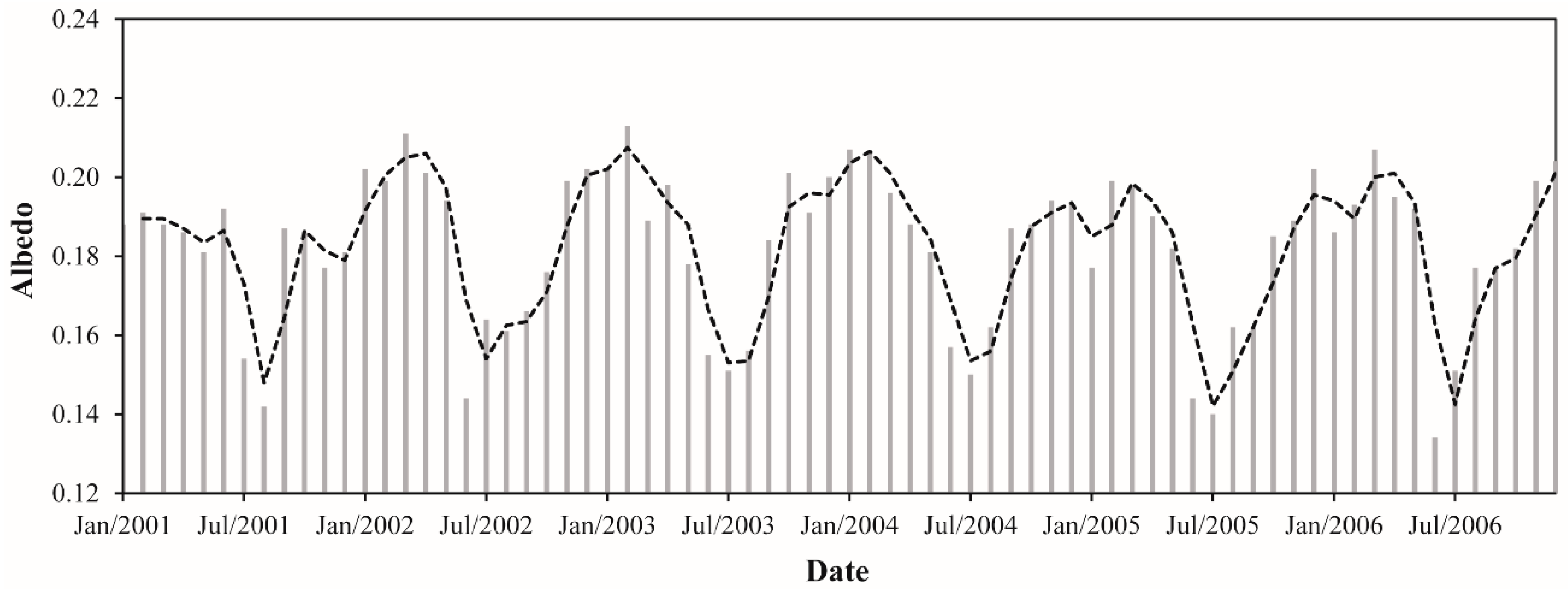
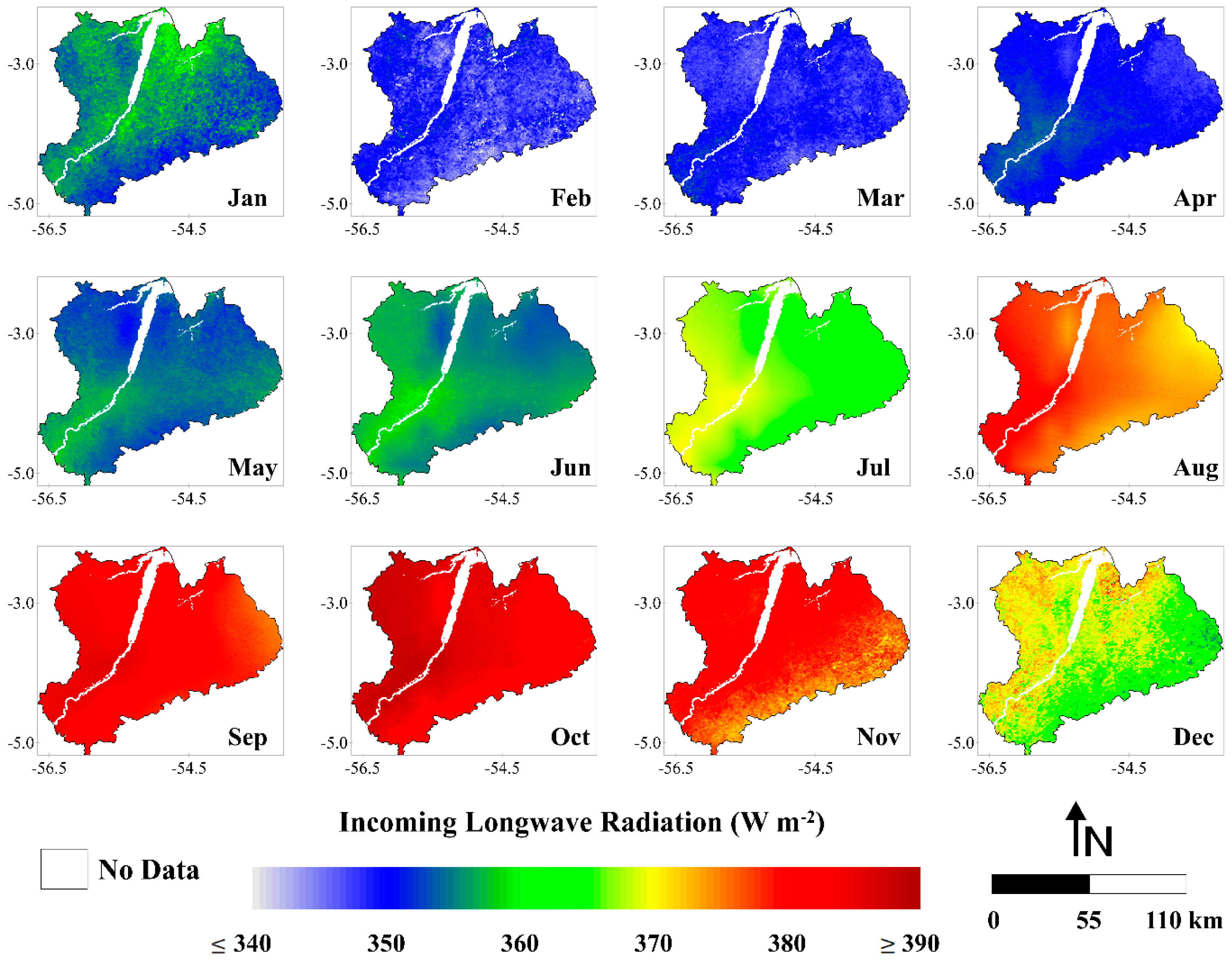



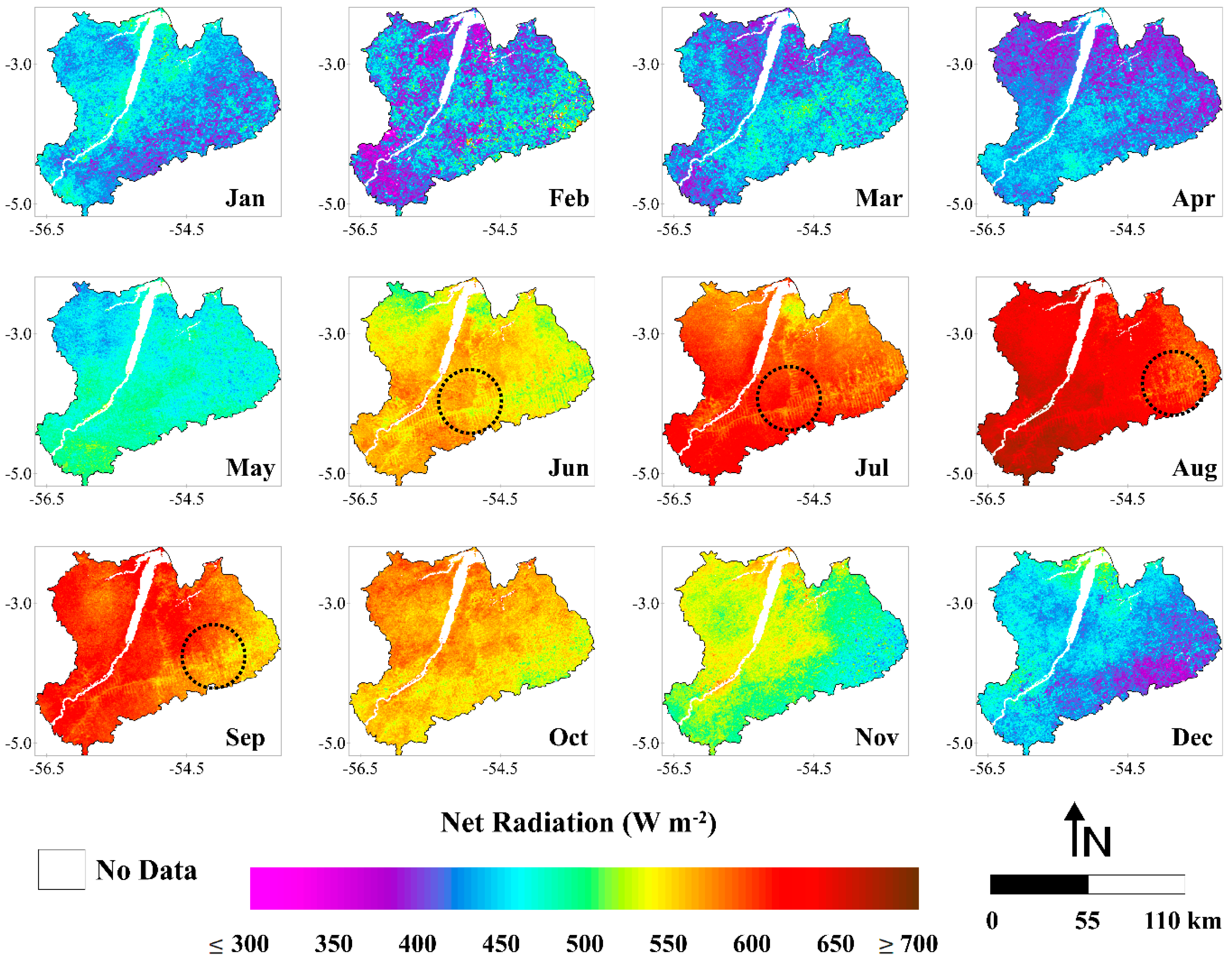
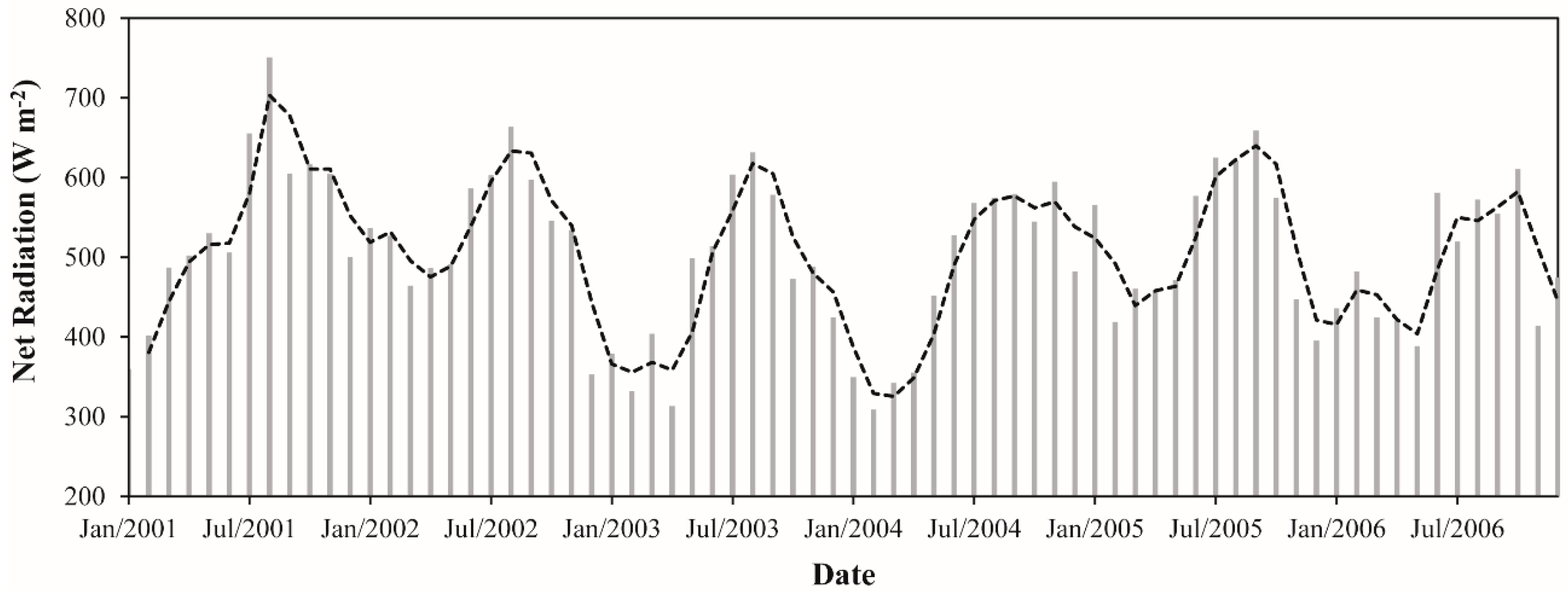




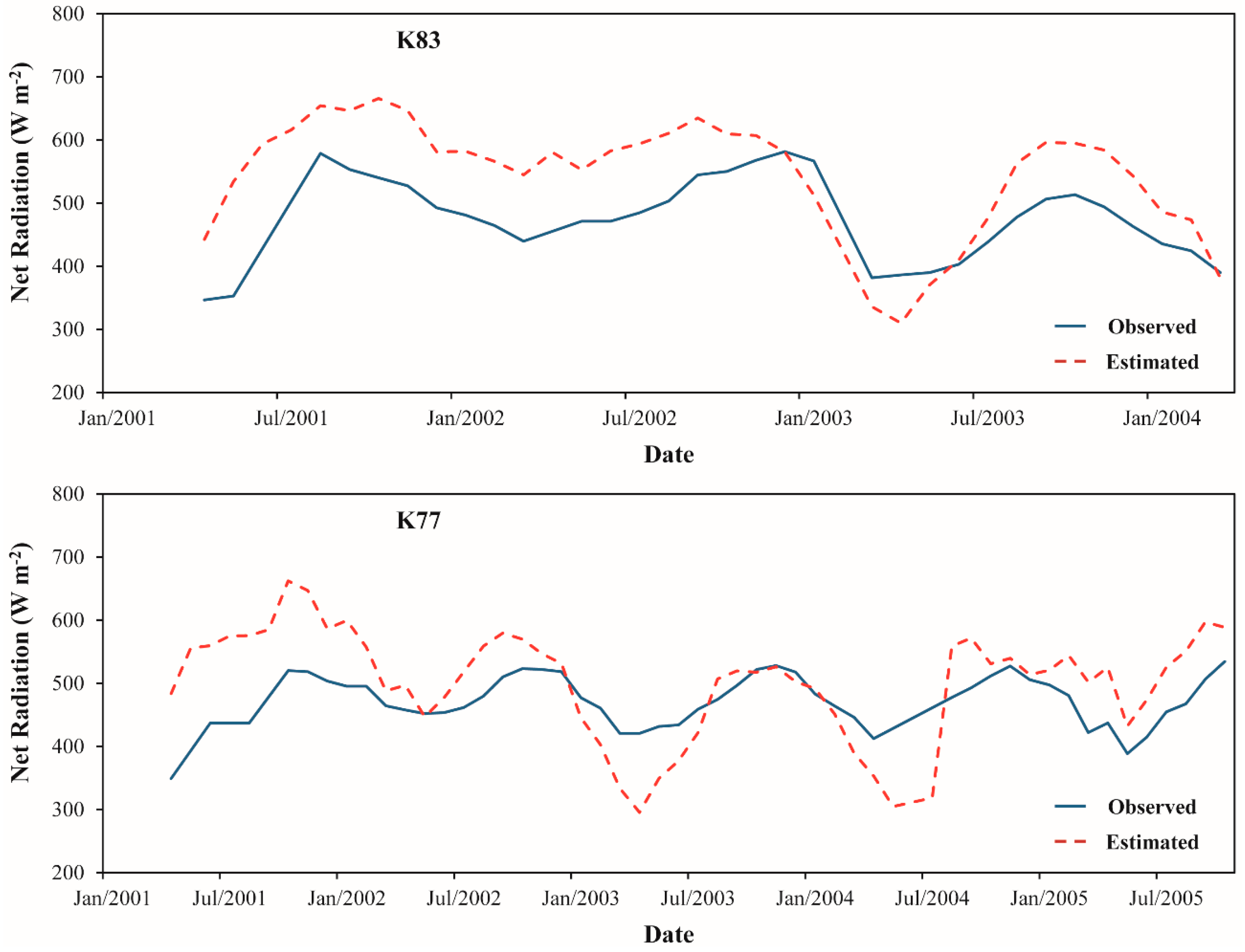
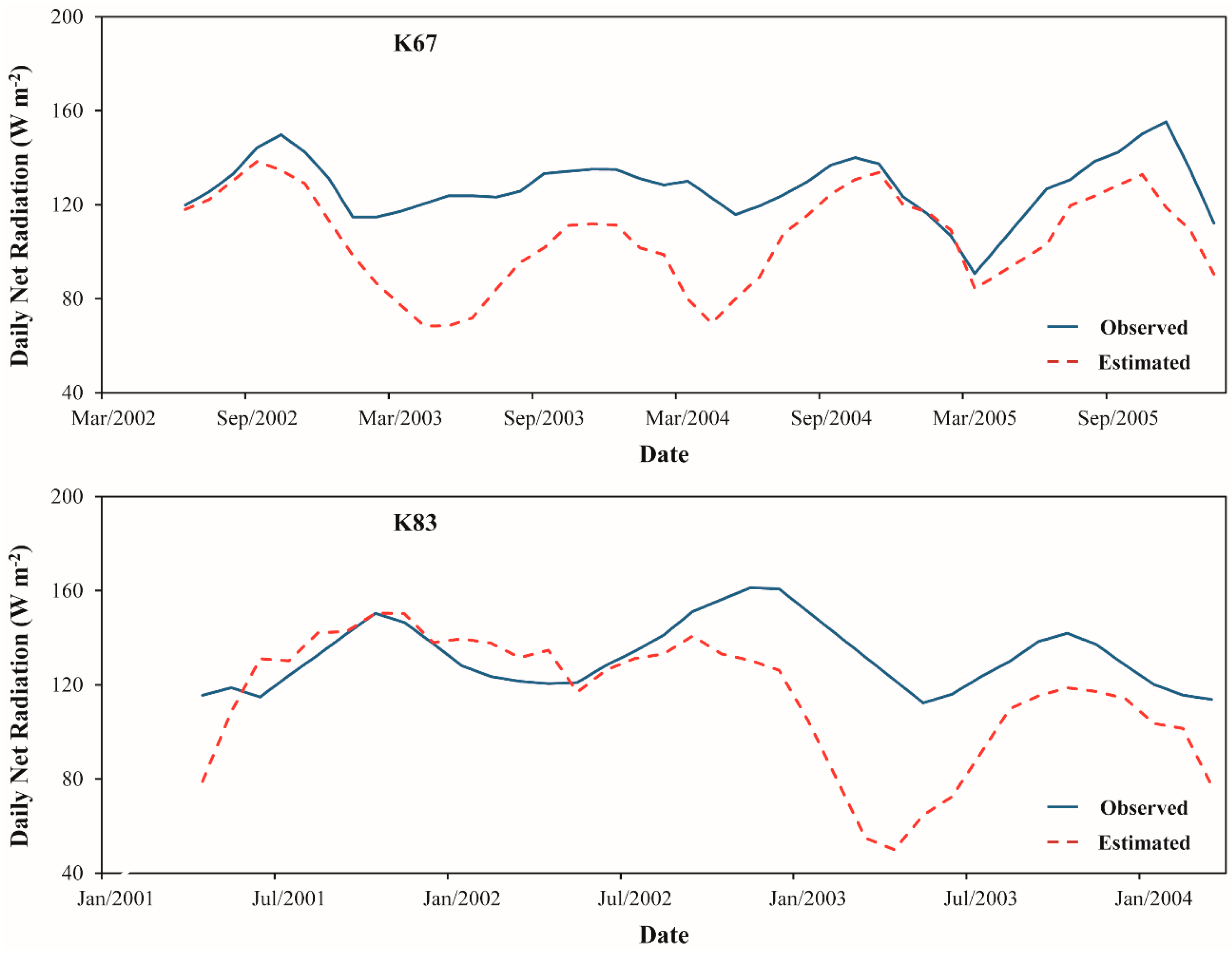
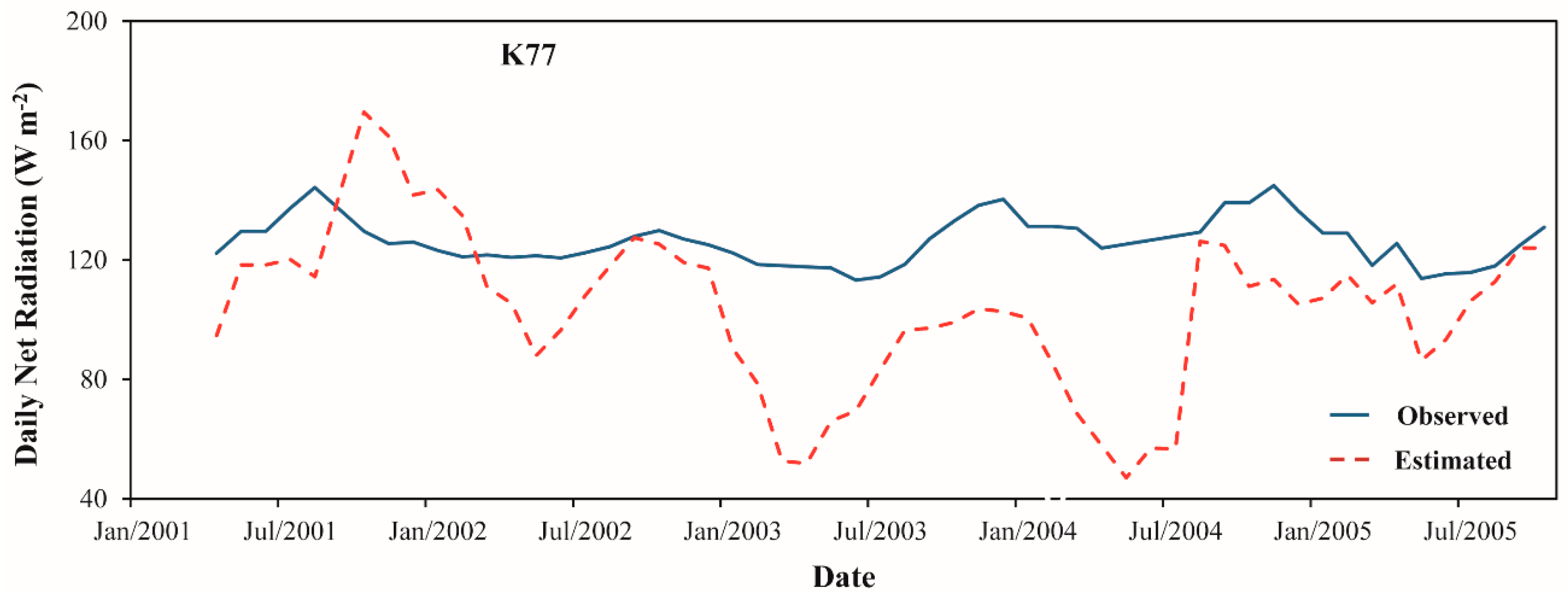
| K67 | K83 | K77 | ||
|---|---|---|---|---|
| Incoming Shortwave Radiation (K↓) (W·m−2) | Mean Obs. | -- | 637.1 | 667.6 |
| Mean Est. | -- | 707.6 | 713.3 | |
| bias | -- | 70.5 | 45.7 | |
| RMSE | -- | 86.5 | 72.7 | |
| r2 | -- | 0.86 | 0.78 | |
| MRE (%) | -- | 11.1 | 9.9 | |
| Daily Incoming Shortwave Radiation (K↓24h) (W·m−2) | Mean Obs. | -- | 189.5 | 200.9 |
| Mean Est. | -- | 226.0 | 226.3 | |
| bias | -- | 36.5 | 25.4 | |
| RMSE | -- | 41.2 | 32.2 | |
| r2 | -- | 0.81 | 0.71 | |
| MRE (%) | -- | 19.5 | 14.0 | |
| Air Temperature (Ta) (°C) | Mean Obs. | 27.2 | 27.4 | 28.9 |
| Mean Est. | 29.0 | 29.0 | 29.1 | |
| bias | 1.8 | 1.6 | 0.2 | |
| RMSE | 2.3 | 2.3 | 1.4 | |
| r2 | 0.84 | 0.77 | 0.78 | |
| MRE (%) | 6.6 | 6.1 | 3.7 | |
| K67 | K83 | K77 | ||
|---|---|---|---|---|
| Albedo | Mean Obs. | -- | 0.110 | 0.169 |
| Mean Est. | -- | 0.153 | 0.197 | |
| bias | -- | 0.044 | 0.028 | |
| RMSE | -- | 0.052 | 0.041 | |
| r2 | -- | 0.18 | 0.14 | |
| MRE (%) | -- | 43.4 | 20.1 | |
| Incoming Longwave Radiation (L↓) (W·m−2) | Mean Obs. | -- | 436.8 | 441.0 |
| Mean Est. | -- | 371.5 | 369.2 | |
| bias | -- | -65.3 | -71.8 | |
| RMSE | -- | 66.6 | 73.9 | |
| r2 | -- | 0.06 | 0.05 | |
| MRE (%) | -- | 14.9 | 16.2 | |
| Outgoing Longwave Radiation (L↑) (W·m−2) | Mean Obs. | -- | 468.7 | 486.9 |
| Mean Est. | -- | 432.3 | 440.4 | |
| bias | -- | -36.4 | -46.5 | |
| RMSE | -- | 37.1 | 47.9 | |
| r2 | -- | 0.34 | 0.59 | |
| MRE (%) | -- | 7.8 | 9.5 | |
| Net Radiation (Rn) (W·m−2) | Mean Obs. | 489.0 | 466.6 | 480.7 |
| Mean Est. | 525.6 | 521.6 | 511.2 | |
| bias | 36.6 | 55.1 | 30.5 | |
| RMSE | 68.2 | 88.8 | 71.6 | |
| r2 | 0.64 | 0.78 | 0.35 | |
| MRE (%) | 12.5 | 16.4 | 13.1 | |
| Daily Net Radiation (Rn24h) (W·m−2) | Mean Obs. | 128.9 | 132.9 | 126.6 |
| Mean Est. | 115.9 | 127.4 | 113.6 | |
| bias | -13.0 | -5.4 | -13.0 | |
| RMSE | 18.7 | 19.7 | 24.8 | |
| r2 | 0.57 | 0.31 | 0.06 | |
| MRE (%) | 11.3 | 12.1 | 15.9 | |
© 2016 by the authors; licensee MDPI, Basel, Switzerland. This article is an open access article distributed under the terms and conditions of the Creative Commons Attribution (CC-BY) license (http://creativecommons.org/licenses/by/4.0/).
Share and Cite
De Oliveira, G.; Brunsell, N.A.; Moraes, E.C.; Bertani, G.; Dos Santos, T.V.; Shimabukuro, Y.E.; Aragão, L.E.O.C. Use of MODIS Sensor Images Combined with Reanalysis Products to Retrieve Net Radiation in Amazonia. Sensors 2016, 16, 956. https://doi.org/10.3390/s16070956
De Oliveira G, Brunsell NA, Moraes EC, Bertani G, Dos Santos TV, Shimabukuro YE, Aragão LEOC. Use of MODIS Sensor Images Combined with Reanalysis Products to Retrieve Net Radiation in Amazonia. Sensors. 2016; 16(7):956. https://doi.org/10.3390/s16070956
Chicago/Turabian StyleDe Oliveira, Gabriel, Nathaniel A. Brunsell, Elisabete C. Moraes, Gabriel Bertani, Thiago V. Dos Santos, Yosio E. Shimabukuro, and Luiz E. O. C. Aragão. 2016. "Use of MODIS Sensor Images Combined with Reanalysis Products to Retrieve Net Radiation in Amazonia" Sensors 16, no. 7: 956. https://doi.org/10.3390/s16070956





